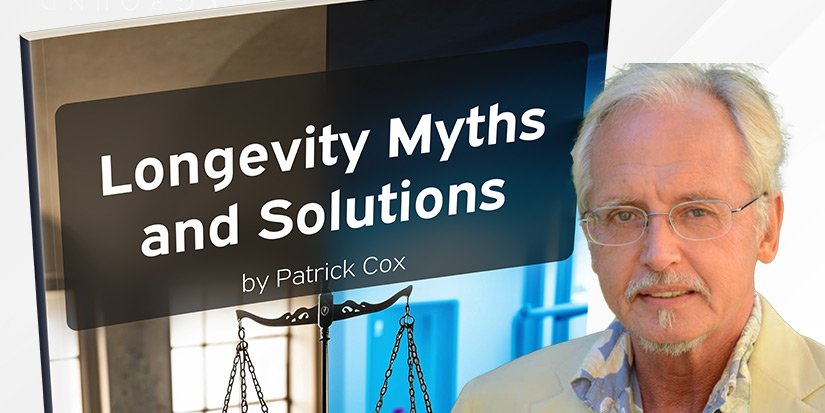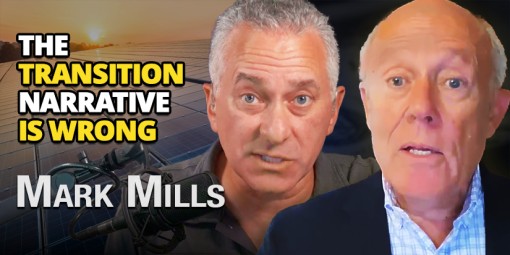
High Yield Train Wreck
-
 John Mauldin
John Mauldin
- |
- May 25, 2018
- |
- Comments
- |
- View PDF
What Are They Selling?
Office Space
Unraveling Dreams
Covenant Lite
Cleveland, Philadelphia, Grand Lake Stream, Beaver Creek, and Boston
My still-unfolding Train Wreck series is getting a lot of attention. It’s not exactly good news, but people at least appreciate the warnings. Thanks to all who sent thought-provoking comments. I always consider them carefully.
A few readers characterized the crisis I foresee as being a repeat of the 2008 fiasco. That’s partly right, in the sense we will have a painful economic and market downturn, but the causes will be quite different.
Last time around, the root problem was excessive residential real estate debt. Reckless lenders made unwise loans so unqualified borrowers could buy overpriced homes. These loans morphed into securities and derivatives and all blew up. I don’t think it will happen that way again. The next crisis will spring from corporate debt, equally imprudent but structurally different.
This train wreck will be similar in one respect, though. The first defaults will occur at the lowest end of the problematic market: high yield or “junk” bonds. They will play a role comparable to subprime mortgages in the last crisis. We’ll see mortgage problems as well, but I think overleveraged companies will be the core problem.
Before we go into that, you might want to review prior installments in this series or read them first if you’re just now joining us.
Today, we’ll look at a not-so-prime example of the reckless investments people are making in high-yield bonds, then consider how big the problem can get.
But we’ll start with a little history.
What Are They Selling?
Older readers will remember a Houston-based company called Enron that blew itself, its employees, and investors to smithereens during the 2001–2002 recession. Investigations followed. Some management (properly) went to prison.
In the late 1990s, Enron engaged former Reagan speechwriter and Wall Street Journal columnist Peggy Noonan to help explain itself to the world. Noonan, possibly the greatest business writer of her generation, couldn’t do it. She described the experience in a 2002 column.
Let me tell you what I saw when I was there. I saw cavernous rooms with big monitors on the walls and on desks too. The monitors and computers were blinking out numbers. I remember the numbers and words on the screens as bright green. Young future Masters of the Universe were standing with phones, monitoring the numbers, saying things, buying and selling. I met with a woman famous in the company for being in charge of putting big natural gas pipelines into Central or South America and India. She seemed intense and intelligent and, like the men, very Armani but kind of Texas Armani—everyone well-tailored but with more gold, more colors than Wall Street people, who are sort of more gray-hued…
And I thought, they spend a lot of money. That was one thing that hit me hard in Houston: They were “hemorrhaging money!” as Tom Wolfe’s Sherman McCoy said. They were building this and tearing down that, they were, they told me, talking to legislators in various state houses, lobbying to get deregulation bills passed. All of it seemed expensive, labor-intensive, time-intensive.
And it all seemed so tentative, so provisional. The Enron building was huge; the Enron sign outside, the big tilted E, was huge; the gold earrings on the women executives were huge; the watches on the men were huge; the paychecks were huge; the company’s ambitions were huge. But all of it seemed to depend on things that were provisional. If they are able to build the big pipeline in India, it will be great and profitable—provided it happens. If they are able to get states to deregulate electricity, and Enron is able to provide it, and it all goes well, it will be great and profitable—if it happens. If the Central or South American pipeline goes through and works and runs a profit it will be great—if it happens. An empire built on ifs. It all seemed so provisional…
I went away for a few weeks and worked hard and tried to put together a speech and make a contribution to the annual report, but none of it really worked… the key part was that I couldn’t help them explain their mission because I didn’t fully understand what their mission was. I understand what the Kenneth Cole shoe company does. It makes shoes and sells them in stores. Firestone makes tires. I couldn’t figure out how Enron was making its money, what exactly it was selling, and every time I asked, I got a kind of gobbledygook answer or a cryptic one, like “The future!”
Sound familiar? That’s probably how you or I would feel if we toured some Silicon Valley unicorns today. They’re very confident and have big dreams. Whether the dreams can ever make money is a different question.
Enron wasn’t entirely vaporware. Those people Peggy Noonan saw really did trade electricity. Before the collapse, it spun off a subsidiary called Enron Oil & Gas which survives today as EOG Resources, a major shale player. But most of the dreams went nowhere, disguised by accounting fictions that eventually fell apart.
This is all obvious now. Back then, it wasn’t. Intelligent, seasoned investors believed Enron really was “the future!” and gave it their hard-earned money not only for equity but for debt. Lots of debt. Enron's bankruptcy filings showed $13.1 billion in debt for the parent company and an additional $18.1 billion for affiliates. But that doesn't include at least $20 billion more estimated to exist off the balance sheet.
Now other investors are buying into today’s dreams. Maybe some will end more happily than Enron did. But you might not want to bet your own financial future on it.
Office Space
I’ve talked about potential problems in the high-yield bond market. That’s the polite name for “junk” bonds, issued by companies that can’t earn an investment-grade rating even from our famously lenient bond rating agencies.
This is a two-layer threat. First, many of these companies are so marginal that even a mild economic downturn could render them unable to make bond payments. The second layer is that bondholders will want to sell those bonds, but the liquidity they presume probably won’t be there.
I could point to many examples, but we’ll take one that was in the news recently: WeWork. The still-private company issued bonds last month, giving the public a peek into the books. The offering raised $702 million at 7.875%—a nice yield if it lasts the full seven-year term. That is if you get your capital back at the end of those years. I’m not convinced investors will.
Like what you're reading?
Get this free newsletter in your inbox every Saturday! Read our privacy policy here.
WeWork, at least, has a clear business model, one proven by other companies, and they are executing with panache and flair. It signs long-term leases for office space, then subleases to the hordes of freelancers and independent contractors who need an inexpensive workspace. Much of it is just tabletop space in open suites. This is apparently attractive to the younger set who like being close to peers, and the price is certainly right. WeWork provides all sorts of amenities which create an enjoyable workplace. Founder Adam Neumann is a charismatic executive who’s obviously adept at raising capital. So, it could last for some time.
The risk is that WeWork’s renters could disappear quickly if their own income dries up, as will happen for many when the economy breaks. Investors seem to believe this risk isn’t just manageable, but negligible.
Grant Williams featured a lengthy WeWork analysis in this month’s Things That Make You Go Hmmm... (You can read it here if you’re an Over My Shoulder subscriber. If you’re not, learn how to become one.) After walking through the numbers and comparing WeWork’s current $20 billion valuation with comparable companies, Grant says investors have essentially gone insane.
The list of investors’ concerns around WeWork belong to a bygone era when those lending a company their precious capital (and foregoing a risk-free return) used to require that company’s assets and liabilities bear some relationship to each other.
Negative cashflow also used to be ‘a thing’ and ‘strategic challenges’ once raised an eyebrow or two.
Not anymore.
Instead, in a world of yield-seeking and minimal due diligence, the combination of a (relatively) juicy yield and the appearance on a company’s register of superstar names like Masayoshi Son is all that’s required for what once counted as material aspects of a company’s business to be forgotten.
Grant isn’t the only skeptic, either. Developer John McNellis ran the numbers and reached this conclusion:
If, instead of merely subleasing 14 million feet, WeWork owned 14 million feet of office buildings at a valuation of say $500 a foot, the company would be worth $7 billion or roughly one-third of its self-touted value. And that $7 billion valuation would presuppose owning all of those buildings free and clear of debt.
McNellis also highlights something important from the bond disclosures.
WeWork neither signs nor guarantees its own leases; rather, for each lease it signs, it creates a single purpose entity [SPE] with very limited capitalization; i.e. its leases carry almost no financial exposure to the parent company. These entities are known as SPE’s (“Screwing Probably Expected”).
So, if WeWork’s renters disappear, the first victims will not be WeWork, but the property owners who leased space to WeWork. They may have little recourse. But they’re probably leveraged themselves, so the losses will flow upstream, eventually to the banking system. And we know where that ends.
Unraveling Dream
Here’s the truly scary part: WeWork isn’t unusual. The landscape is littered with similarly tenuous corporate borrowers. It is the inevitable consequence of a free-cash decade. Here’s Grant Williams again.
Ten years into the ongoing laboratory experiment being conducted by the world’s central banks, everywhere you look there are multiple examples of the kind of lunacy those policies have fomented by reducing the cost of capital to virtually zero and forcing investors to take risks they would ordinarily avoid in order to find some kind of return.
WeWork is one example of a company for whom, in the face of rapid growth, massive negative cashflows aren’t a problem, but there are plenty of others. Uber, AirBnB, SnapChat and, of course, Tesla have all captured the imagination of investors thanks to lofty dreams, articulated by charismatic CEOs—but the day things turn around and the economy begins to weaken or, God forbid, investors seek a return on their investment as opposed to settling for rolling promises of gigantic, game changing revenues to come, it is over.
Look, I’m all about “lofty dreams.” I have them myself. I admire entrepreneurs who take risks and break new ground. They are the key to economic growth. Building a business is the single best and most effective way to create personal wealth. But it’s also true that most of those dreams are simply dreams and will never come true. A few who bet on them win big, but most lose some or all of their investment.
Adam Neumann at WeWork has convinced investors that his office space rental company should actually be viewed as a technology company. We are creating a “community” he says. Whatever that is. There is a successful and larger competitor whose valuation is roughly 10% of WeWork. But then, they are in the office space rental business, not the “creating a community/building the future” business.
A long line of businessmen and women seemingly have the gift to convince investors to buy unrated paper that is unsecured with no assets behind it. The problem is that unraveling dreams tend to be contagious. Investor psychology is fragile, so the collapse of one high-profile dream can bring lesser-known ones down, too. I think we’re approaching that point.
Yet something interesting and a little counterintuitive is happening. You might think the yield on bonds issued by risky companies would rise as the cycle matures. That would be consistent with investors demanding more compensation for their risk. But it hasn’t happened that way.
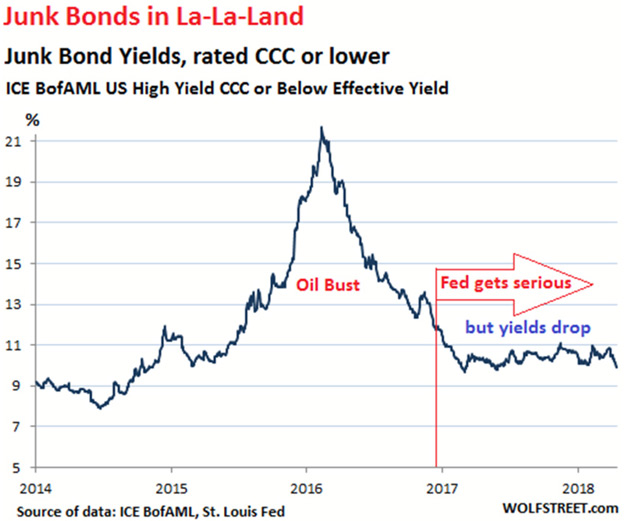
Source: Wolfstreet.com
After spiking higher during the 2015–2016 oil bust, when many shale drillers had serious problems, yields dropped in 2017. Not by coincidence, that’s also when the Federal Reserve began hiking rates every quarter. Fearing capital losses, Treasury investors relaxed their credit standards and created more demand for junk bonds, which sent those yields lower. That’s my theory, at least.
We’re seeing classic end-of-cycle behavior: throw caution to the wind and plunge capital into the market’s riskiest corners. This artificially-induced buying is propping up companies that would otherwise succumb to the fundamental forces arrayed against them.
Nor is it simply a junk-bond problem; the investment-grade corporate market is becoming measurably riskier. Here’s a Dave Rosenberg chart that my friend Steve Blumenthal shared recently.

Source: On My Radar
Almost half of investment-grade companies are rated BBB, just one step above junk, up from just one-third in 2009. When the economy breaks, some of those companies will run into trouble. Some of those will get downgraded, which will force many funds to sell them, thereby intensifying the liquidity storm I’ve described.
A few companies will probably default. Bondholders may have little recourse to recover their principal, having accepted covenant-lite conditions and taken on leverage themselves.
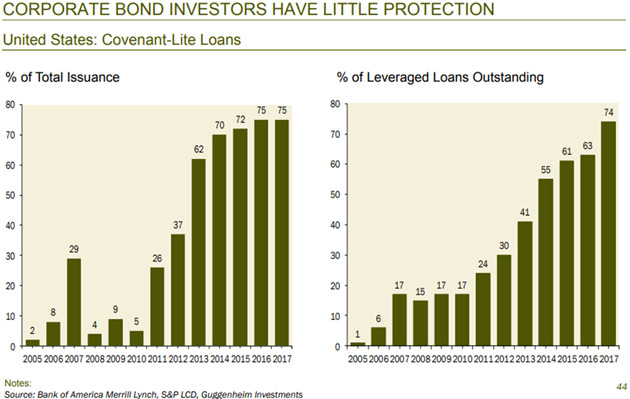
Source: On My Radar
Like what you're reading?
Get this free newsletter in your inbox every Saturday! Read our privacy policy here.
Leveraged lenders will be in a pickle when the defaults begin, but they won’t be the only ones. It all flows downstream. Whoever extended credit to leveraged loan buyers will be in trouble, too. That’s how problems in one market spread to others.
Covenant Lite
Let’s explore what we mean by the term covenant lite. Borrowers can become extraordinarily creative.
Covenant-lite loans is a type of financing that is granted with limited restrictions. Traditional loans generally have protective covenants built into the contract that protect the lender, including financial maintenance tests that measure the debt-service capabilities of the borrower. The issuance of covenant-lite loans means that debt is being issued to borrowers with less restrictions on collateral, payment terms, and level of income. Covenant-lite loans place less restrictions on the borrower in terms of requiring collateral and a certain level of income. Covenant-lite loans are also referred to as cov-lite loans. (Investopedia)
Some covenant-lite loans let the borrower repay with freshly issued debt—in essence, printing their own money. Others allow them to borrow even more money, perhaps pledging assets that should have gone to the company, in order to let the firm’s initial private equity investors pull out equity. This effectively transfers additional risk to bondholders.
The closest comparison I can imagine is the dot-com run up to 2000, and the debt is still growing. While high-yield bond issuance dropped somewhat over the last few years, leveraged loans at the same companies are up 12% since 2014.
There is a lot of overlap in the companies that issue high-yield bonds and issue debt (loans), and it is no coincidence that the rapid increase in leveraged loans has coincided with a period of decline for high-yield debt. Since the end of 2014, the US high-yield market has shrunk by 3.7% while the loan market has grown by 12.7%.
In aggregate, the combined size of the US loan and high-yield bond markets has been broadly stable since 2014 (chart 2). Again, this is very different to the wave of mega-leveraged buyouts (LBOs), which expanded the high-yield and loan markets in the 2005–2007 period.
Chart 2: combined size of US high yield and loan markets
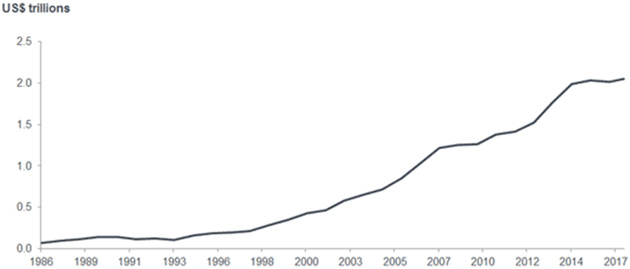
Source: BofA Merrill Lynch, Janus Henderson Investors, as at September 30, 2017
My data sources show different amounts of high-yield bond issuance, but all show a lot of it. Looking at just the Morningstar high-yield category, I see $1.4 trillion in mutual funds and almost $650 billion in high-yield ETFs. Some of these funds are well-managed and some are so large they buy anything (maybe including WeWork) because they need to invest their incoming cash.
Those numbers don’t count high-yield bonds held outside of funds and ETFs. As this National Association of Insurance Commissioners chart shows, the insurance industry has $240 billion worth of high-yield debt which represents 5.9% of their total bond investments.
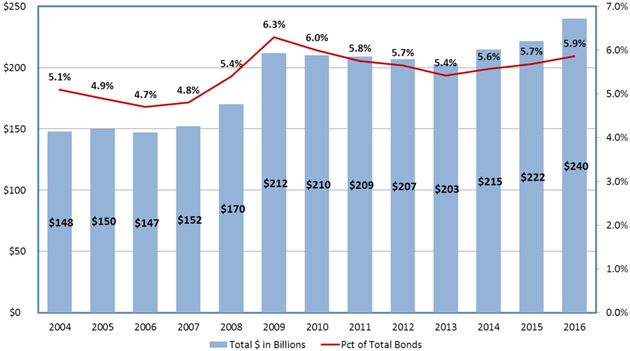
Source: National Association of Insurance Commissioners
Then there are pensions, foundations, and endowments that have their own exposure to high-yield bonds.
The difference is (this is a big generality) institutional investors are typically buying specific bonds, so they don’t quite get the exposure to some of the extreme jumps. Further, they can hold to maturity, making liquidity less of an issue.
The roughly $2 trillion in high-yield bond funds and ETFs get marked-to-market every day. This means individual investors can see their values go down as well as up. If losses make enough of them begin to withdraw, it will force those funds to sell into a shrinking market, putting further pressure on valuations.
In a plunging market, you don’t sell what you want, you sell what you can. Funds have to meet redemptions. That means increasingly lower-rated bonds remain for investors who don’t move early. Valuations drop and it just cascades.
A decade ago, we saw a subprime mortgage debt crisis bleed into the rest of the markets. I think this time, the high-yield debt crisis will have the same result. Next week, we will look at The Second Act. Later on, we’ll get to emerging market debt and perhaps even worse, the non-corporate grade bond market in Europe—and don’t get me started on the problems in China.
This is a long story and we’re still at the beginning.
Cleveland, Philadelphia, Grand Lake Stream, Beaver Creek, and Boston
Shane and I are mostly home for the summer, where I intend to spend more gym and writing time. At some point, we will take a quick two-day trip to Cleveland to go through the Cleveland Clinic’s executive health checkup program with our friend Dr. Mike Roizen. We are trying to arrange a few other meetings there which has the schedule unclear at this point.
In August, I will take my traditional Camp Kotok fishing trek with many friends and my youngest son at Grand Lake Stream, Maine. Later that month, Shane and I will go to Beaver Creek, Colorado for an Ashford board meeting. We also plan to visit Woody Brock at his summer home in Gloucester and then drive down to Newport, Rhode Island to spend a few days with Steve Cucchiaro and his fiancée, Jama, on their catamaran. That’s actually a pretty relaxed travel schedule for me.
This weekend, some of the clan will gather as Amanda Mauldin Porter, her husband Allen, and their two young daughters (my granddaughters) will be here from Tulsa. Much of the rest of the family will come by to see them.
Much is happening in my business and writing life that I will be able to talk about in a few weeks. It should “buy” me significantly more time each week to do what I like: reading, research, writing, and thinking. That will hopefully improve the letters and other research. Maybe it will even open some opportunities for you. We will see….
Like what you're reading?
Get this free newsletter in your inbox every Saturday! Read our privacy policy here.
It’s time to hit the send button. I have committed to finishing the letter much earlier each week, so it can reach your inbox early Saturday morning. This has forced me to completely rework my life schedule, but after being in the rhythm for a few weeks, I realize how much more fun (and productive!) I am without a deadline hanging over me. My partners have urged me to do this for years, but I couldn’t get out of my scheduling rut. They finally presented irrefutable data showing I needed to finish earlier, so I rescheduled my life. Best thing I’ve done in a long time.
Your here to help you get through to the other side of The Great Reset analyst,

John Mauldin
P.S. If you like my letters, you'll love reading Over My Shoulder with serious economic analysis from my global network, at a surprisingly affordable price. Click here to learn more.
Tags
Suggested Reading...
|
|
Did someone forward this article to you?
Click here to get Thoughts from the Frontline in your inbox every Saturday.

 John Mauldin
John Mauldin